Hands On with the ZTE Axon M
Oct 17, 2017, 9:40 AM by Eric M. Zeman
updated Oct 19, 2017, 9:05 AM
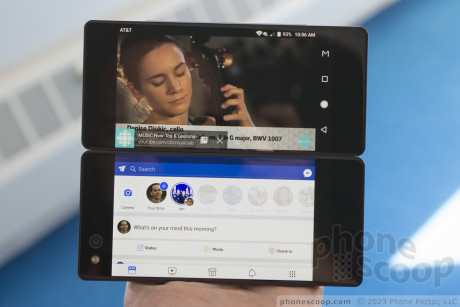
ZTE is trying something different with the Axon M. Rather than push out another boring slab, ZTE created an interesting Android smartphone with twin folding displays that can be set in a number of different and useful configurations. Need extra screen real estate in that document, or want to run two full-screen apps side by side? The Axon M does that and more. Here are Phone Scoop's first impressions of this AT&T-exclusive handset.
First, the M may carry the Axon brand, which ZTE reserves for its flagship devices, but the M is not a flagship flagship. It's not meant to contend with the S8, Note8, or iPhone 8. It's its own thing. The Axon 8, if there is such a device, won't arrive for a bit longer.
The foldable Axon M from ZTE stands out in today's veritable sea of slab-style smartphones. Though the Axon M isn't the very first phone to take the two-screen approach, it's the first significant entry we've seen in the modern smartphone era. That makes it one of the more interesting devices we've seen in recent memory. Moreover, the phone has full support from a U.S. carrier, in this case AT&T, which means U.S. consumers will have an opportunity to buy this device before too long. Let's dig in, shall we?
ZTE admits that it was AT&T that approached the company about creating something different. The Axon M owes its impetus to the AT&T/DirecTV merger. AT&T asked ZTE to create a device that delivers a unique video experience, something AT&T could use to pitch its DirecTV video service to wireless customers. (NTT DoCoMo will sell the phone in Japan, though it's not clear how much of a role DoCoMo played in the Axon M's inception.) The main focus was to create a phone with a bigger screen that's not the size of a tablet. Most people won't buy a phone with a screen larger than 6 inches, according to ZTE, as devices larger than that are viewed as tablets. People don't want to carry tablets around all the time.
The result of this effort is the Axon M, a device with two 5.2-inch full HD displays that fold out to create one, big 6.9-inch screen.
The folding design necessitates a blocky appearance. You've got glass on the front and back surfaces, and a solid aluminum chassis in between. The glass has a 2.5D curved shape and is protected by Gorilla Glass 5. The Axon M does not fold perfectly in half; rather, the rear surface swings around on a strong hinge to meet the front screen. The two are perfectly lined up. If you fully open the screen and view the Axon M from the bottom edge, you'll see the left side is twice as thick as the right. Even so, I didn't find the Axon M awkward or unbalanced to hold when open.
It may be a bit thick at 12.1mm, but the Axon M is a fairly decent size all things considered. It measures 5.94 inches tall by 2.82 inches wide. These help the phone feel narrow(ish) and not too tall. The thickness hurts a bit, but it's not the worst we've encountered. The weight is pretty bad: the Axon M weighs in at a full half pound. The aluminum chassis, glass, and hinge make for a heavy phone that you'll know you're carrying around. The blocky footprint isn't the most hand-friendly I've used. It feels cold and brick-like in your hand. Good luck getting this device into your pockets. The thickness and shape together make it a tight, uncomfortable squeeze into tight pockets.
If you look at the M's face, it may remind of you of Sony's Xperia phones. You've got a smallish display with moderately slim side bezels and annoyingly thick forehead and chin bezels. I wish there were a bit less framing around the displays. The huge camera and dual LED flash are plainly visible on the phone's front side.
On their own, the twin 5.2-inch screens are decent. The LCD panels put out plenty of light and offer excellent pixel density thanks to the combination of size and full HD resolution. Together, the screens don't quite deliver the experience for which I was hoping.
There are two issues. First, the bezels. With both screens open, a thick black line bifurcates the two displays. It's something I was hoping would sort of vanish after using the phone for a while, but no, it remains obvious all the time. This is distracting. Second, the color of the individual displays is not properly matched. The left (main) display has a more bluish tint while the right (second) display has a more yellow tint. This discrepancy is incredibly obvious when you're browsing a web page that spreads across both screens. The latter we may be able to write off to pre-production hardware, but the former is surely something that will be there all the time. ZTE told us it hopes to reduce the thickness of the black, central bezel on future generations of the Axon M.
ZTE encircled the Axon M in an aluminum frame. All the buttons are on the left side of the phone. A volume toggle is closest to the top. It has a decent profile, but action was rather mushy. The screen lock button is actually recessed a bit from the surface of the side edge. It doubles as a fingerprint reader. I didn't have any trouble locating it and the action was pretty decent. Last, ZTE included a dedicated camera button and positioned it closer to the bottom of the left edge. It is a two-stage key that has good travel and feedback.
The right side of the phone is one giant hinge. It feels really strong. ZTE included a 3.5mm headphone jack on top, and a USB-C port on the bottom — standard stuff that most people will appreciate.
In all, the hardware is pretty good. It's definitely unique. I understand the limitations of today's hardware, and there's no question ZTE put together a more compelling device than the 2011-era Kyocera Echo
Hardware is only half the story here. ZTE has done a lot of work on the software in order to make the phone function seamlessly as you open, close, and otherwise move the dual displays around.
The dual displays operate in three basic modes: one big screen, split screen multitasking, and mirror-screen showing the same thing on both. You can jump between viewing modes thanks to a little slide tool that appears at the bottom of the main screen. Simply swipe left or right to access any of the view mode. How do they work?
The first one is pretty obvious. Under the hood, the Axon M is simply loading the tablet view of the app to fill the full 6.9-inch, 1920 by 2,160 space. If you're writing a document you suddenly have way more real estate. If you're browsing a web site, you can suddenly see the entire page. If you're watching video, you can spread it across both screens. ZTE says most apps that support tablet mode should be able to make the jump to full-screen view without any effort.
Single Screen
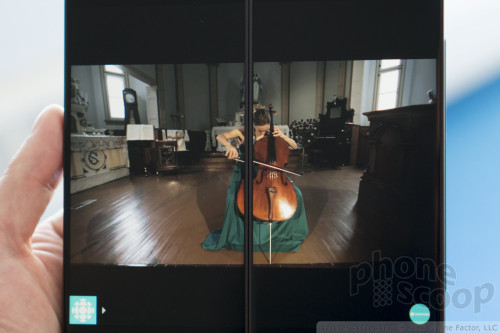
The second mode is for power users. This lets you run two full apps at a time, one on each screen. It's multitasking at its best. You now have twice as much real estate as a single-screen phone for referencing your calendar while composing emails and so on. ZTE says this is one of the modes it had in mind when developing the device. One of today's more popular activities is to use social media while viewing video. People like to comment on sports events, concerts, and other television shows in real time. With the Axon M, you can drop a full-screen YouTube video on the top screen and then open Twitter or Facebook below it and file snarky comments with ease.
Splitscreen
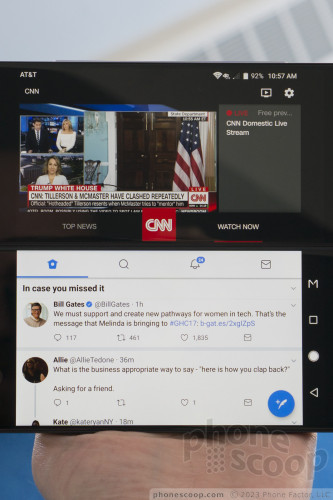
The third mode is called mirror and performs as the name implies. Fold the Axon M into a tent-like shape, place it on a table with one screen facing you and the other facing your bestie, and you can both watch the same stuff at the same time. That means sharing videos, or even playing games like Battleship. (ZTE says a few of these will be available to start, with more coming soon.)
Mirror Mode
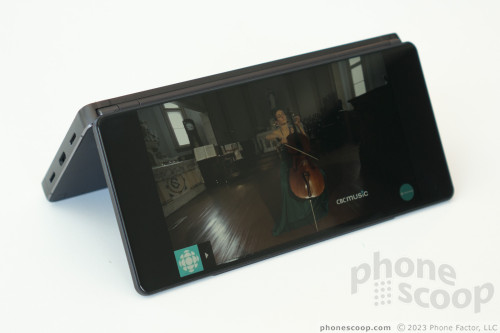
How many apps support all these modes? Well, ZTE says it has played the Axon M's development close to its chest in order to keep it secret. That means so far only Google has had access to the tools needed to adjust apps for dual-screen mode. ZTE plans to offer developers an open-source set of tools to update their own apps for the twin-screen design. ZTE believes game developers will be quick to roll out support for the Axon M, particularly where two-player games are concerned.
In the little bit of time we spend with the Axon M, we can say that these basic operational modes do what ZTE claims they do. I saw a few performance bugs here and there, but the phone isn't ready to sale yet so we can forgive a less-than-perfect experience at the moment.
The one other app most impacted by the Axon M's dual-screen design is of course the camera. There is no room on the rear of the phone for a second camera, so ZTE gave the Axon M a single camera. It does double duty as your main camera and your selfie camera. ZTE tweaked its camera application accordingly. When you want to shoot landscapes, for example, you hold the phone with the main screen facing outward. The controls appear on the rear display. The opposite is true when shooting selfies, as the camera and display are on the same side. You get the picture. (Ha!)
ZTE claims all this won't impact battery life too much. The phone has a 3,180mAh battery. I would prefer to see something closer to 4,000mAh in a phone with two screens. ZTE said it did what it could to minimize the power draw from both screens, and its models still show the device lasting a full day even with plenty of dual-screen use.
At first blush, I'm happy to see a handset like the Axon M make big debut at a splashy NYC event. Smartphone hardware has become exceedingly boring with today's gobs of slabs. It is far more difficult for device makers to get their hardware to stand out, and the Axon M easily stands apart from the field.
The phone is more expensive than I was hoping. AT&T will sell the phone for $24 per month for 30 months. That totals a whopping $725. Ouch. It will go on sale around Thanksgiving. If you're looking for something different this holiday season, the ZTE Axon M is one to keep an eye on.
Comments
No messages


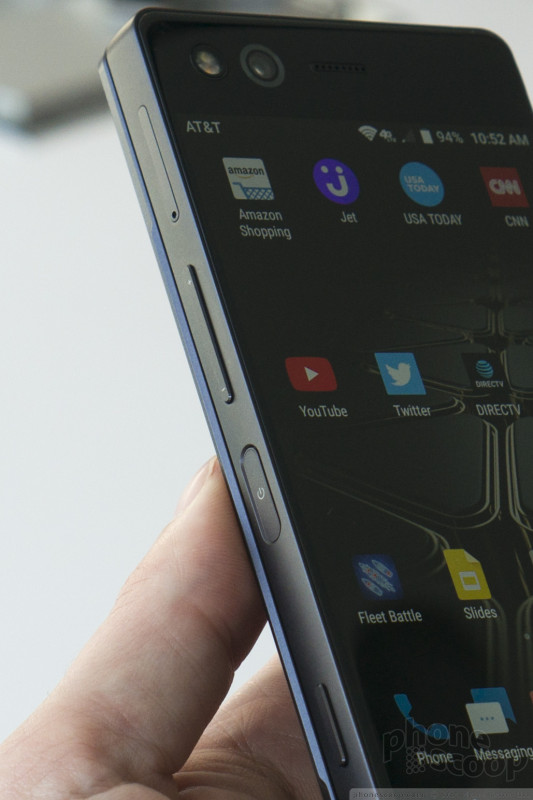










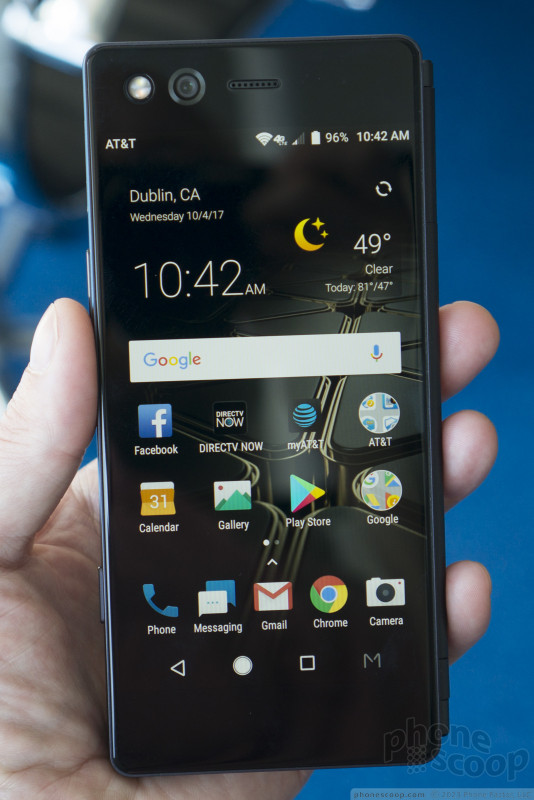








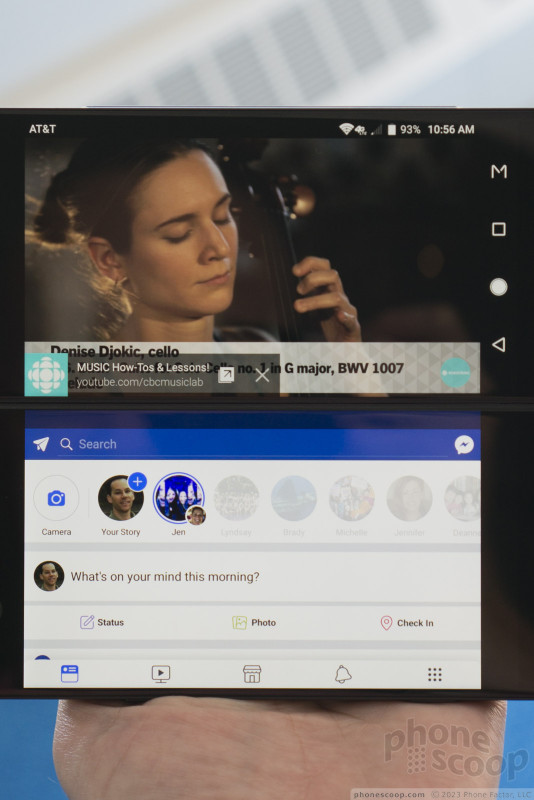








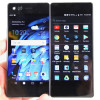 Review: ZTE Axon M for AT&T
Review: ZTE Axon M for AT&T
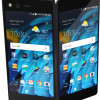 ZTE's Axon M Boasts Dual, Folding Displays to Create Tablet-Sized Screen
ZTE's Axon M Boasts Dual, Folding Displays to Create Tablet-Sized Screen
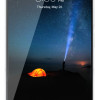 ZTE's Axon 7 Gains a Security Patch
ZTE's Axon 7 Gains a Security Patch
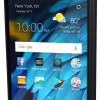 AT&T Says Axon M Will Reach Stores November 17
AT&T Says Axon M Will Reach Stores November 17
 Hands On with the HMD Fusion and its Smart Outfits
Hands On with the HMD Fusion and its Smart Outfits
 ZTE Axon M
ZTE Axon M




